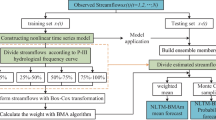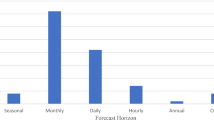Abstract
Forecast calibration methods based on historical similar atmospheric state are effective means weather forecast accuracy. Conventional approaches search similar forecasts on the basis of predefined similarity formulas and provide calibration recommendations to forecasters. However, these approaches ignore the uncertainty of similarity measurement, which affects calibration efficacy significantly. This study proposes a similarity weight adaptive algorithm for high-dimensional data on the basis of fuzzy clustering to characterize the uncertainty of similarity measurements. Without prior knowledge, the algorithm computes the uncertainty of the similarity between data in the fuzzy set space iteratively on the basis of membership and then determine weight distribution by maximizing the differentiating ability of each dimension. This study further presents a visual analysis framework on the basis of the weight adaptive algorithm for the exploration of uncertainty in meteorological data and the optimization of similarity measurement method. This framework has coordinated views and intuitive interactions to enable the visualization of the similarity uncertainty distribution and support the iterative visual analysis of similarity weight distribution in each dimension that combines domain knowledge. We illustrate a case study using real-world meteorological data to verify the efficacy of the proposed approach.
Graphic abstract






Similar content being viewed by others
References
Berthold MR, Hall LO (2003) Visualizing fuzzy points in parallel coordinates. IEEE Trans Fuzzy Syst 11(3):369–374
Bezdek JC (2013) Pattern recognition with fuzzy objective function algorithms. Springer, Berlin
Bonneau G-P, Hege H-C, Johnson CR, Oliveira MM, Potter K, Rheingans P, Schultz T (2014) Overview and state-of-the-art of uncertainty visualization. In: Shriver B (ed) Scientific visualization. Springer, Berlin, pp 3–27
Du J, Kang Z (2014) A survey on forecasters view about uncertainty in weather forecasts. Adv Meteorol Sci Technol 4(1):60–69
Ferstl F, Bürger K, Westermann R (2016a) Streamline variability plots for characterizing the uncertainty in vector field ensembles. IEEE Trans Vis Comput Gr 22(1):767–776
Ferstl F, Kanzler M, Rautenhaus M, Westermann R (2016b) Visual analysis of spatial variability and global correlations in ensembles of iso-contours. In: Hauser H, Benes B (eds) Computer graphics forum, vol 35. Wiley, New York, pp 221–230
Ferstl F, Kanzler M, Rautenhaus M, Westermann R (2017) Time-hierarchical clustering and visualization of weather forecast ensembles. IEEE Trans Visual Comput Gr 23(1):831–840
Gasch AP, Eisen MB (2002) Exploring the conditional coregulation of yeast gene expression through fuzzy k-means clustering. Genome Biol 3(11):research0059.1
Glahn HR, Lowry DA (1972) The use of model output statistics (MOS) in objective weather forecasting. J Appl Meteorol 11(8):1203–1211
Gong C, Chen L, Zhu Z (2016) A visualization system for calibrating multimodel ensembles in weather forecast. J Vis 19(4):769–782
Hamill TM, Whitaker JS (2006) Probabilistic quantitative precipitation forecasts based on reforecast analogs: theory and application. Mon Weather Rev 134(11):3209–3229
Hamill TM, Bates GT, Whitaker JS, Murray DR, Fiorino M, Galarneau TJ Jr, Zhu Y, Lapenta W (2013) Noaa’s second-generation global medium-range ensemble reforecast dataset. Bull Am Meteorol Soc 94(10):1553–1565
Hamill TM, Scheuerer M, Bates GT (2015) Analog probabilistic precipitation forecasts using GEFS reforecasts and climatology-calibrated precipitation analyses. Mon Weather Rev 143(8):3300–3309
Hou D, Charles M, Luo Y, Toth Z, Zhu Y, Krzysztofowicz R, Lin Y, Xie P, Seo D-J, Pena M et al (2014) Climatology-calibrated precipitation analysis at fine scales: statistical adjustment of stage IV toward CPC gauge-based analysis. J Hydrometeorol 15(6):2542–2557
Leutbecher M, Palmer TN (2008) Ensemble forecasting. J Comput Phys 227(7):3515–3539
Liao H, Chen L, Song Y, Ming H (2016) Visualization-based active learning for video annotation. IEEE Trans Multimed 18(11):2196–2205
Liao H, Wu Y, Chen L, Chen W (2018) Cluster-based visual abstraction for multivariate scatterplots. IEEE Trans Vis Comput Gr 24(9):2531–2545
Liao H, Wu Y, Chen L, Hamill TM, Wang Y, Dai K, Zhang H, Chen W (2015) A visual voting framework for weather forecast calibration. In: 2015 IEEE scientific visualization conference (SciVis), pp 25–32
Mao J, Jain AK (1995) Artificial neural networks for feature extraction and multivariate data projection. IEEE Trans Neural Netw 6(2):296–317
Mirzargar M, Whitaker RT, Kirby RM (2014) Curve boxplot: generalization of boxplot for ensembles of curves. IEEE Trans Vis Comput Gr 20(12):2654–2663
Pfaffelmoser T, Reitinger M, Westermann R (2011) Visualizing the positional and geometrical variability of isosurfaces in uncertain scalar fields. In: Hauser H, Benes B (eds) Computer graphics forum, vol 30. Wiley, New York, pp 951–960
Pfaffelmoser T, Mihai M, Westermann R (2013) Visualizing the variability of gradients in uncertain 2d scalar fields. IEEE Trans Vis Comput Gr 19(11):1948–1961
Potter K, Wilson A, Bremer P-T, Williams D, Doutriaux C, Pascucci V, Johnson CR (2009) Ensemble-vis: a framework for the statistical visualization of ensemble data. In: 2009 IEEE international conference on data mining workshops, pp 233–240
Raftery AE, Gneiting T, Balabdaoui F, Polakowski M (2005) Using Bayesian model averaging to calibrate forecast ensembles. Mon Weather Rev 133(5):1155–1174
Rueda L, Zhang Y (2006) Geometric visualization of clusters obtained from fuzzy clustering algorithms. Pattern Recognit 39(8):1415–1429
Ruspini EH (1969) A new approach to clustering. Inf Control 15(1):22–32
Sanyal J, Zhang S, Dyer J, Mercer A, Amburn P, Moorhead R (2010) Noodles: a tool for visualization of numerical weather model ensemble uncertainty. IEEE Trans Vis Comput Gr 16(6):1421–1430
Sharko J, Grinstein G, Marx KA (2008) Vectorized radviz and its application to multiple cluster datasets. IEEE Trans Vis Comput Gr 14(6):1427–1444
Sharko J, Grinstein G (2009) Visualizing fuzzy clusters using radviz. In: 2009 IEEE 13th International conference information visualisation, pp 307–316
Wang Y, Fan C, Zhang J, Niu T, Zhang S, Jiang J (2015) Forecast verification and visualization based on Gaussian mixture model co-estimation. In: Hauser H, Benes B (eds) Computer graphics forum, vol 34. Wiley, New York, pp 99–110
Wang J, Liu X, Shen H-W, Lin G (2017) Multi-resolution climate ensemble parameter analysis with nested parallel coordinates plots. IEEE Trans Vis Comput Gr 23(1):81–90
Whitaker RT, Mirzargar M, Kirby RM (2013) Contour boxplots: a method for characterizing uncertainty in feature sets from simulation ensembles. IEEE Trans Vis Comput Gr 19(12):2713–2722
Zadeh LA, Klir GJ, Yuan B (1996) Fuzzy sets, fuzzy logic, and fuzzy systems: selected papers, vol 6. World Scientific, Singapore
Zhao Y, Luo F, Chen M, Wang Y, Xia J, Zhou F, Wang Y, Chen Y, Chen W (2018) Evaluating multi-dimensional visualizations for understanding fuzzy clusters. IEEE Trans Vis Comput Gr 25(1):12–21
Acknowledgements
We are grateful for the valuable feedback and comments provided by the anonymous reviewers. This research is partially supported by the National Natural Science Foundation of China (Grant Nos. 61972221, 61572274) and NNW2018-ZT6B12 (National Numerical Windtunnel project).
Author information
Authors and Affiliations
Corresponding author
Additional information
Publisher's Note
Springer Nature remains neutral with regard to jurisdictional claims in published maps and institutional affiliations.
Rights and permissions
About this article
Cite this article
Huang, R., Chen, L. & Yuan, X. A visual uncertainty analytics approach for weather forecast similarity measurement based on fuzzy clustering. J Vis 24, 317–330 (2021). https://doi.org/10.1007/s12650-020-00709-z
Received:
Revised:
Accepted:
Published:
Issue Date:
DOI: https://doi.org/10.1007/s12650-020-00709-z




